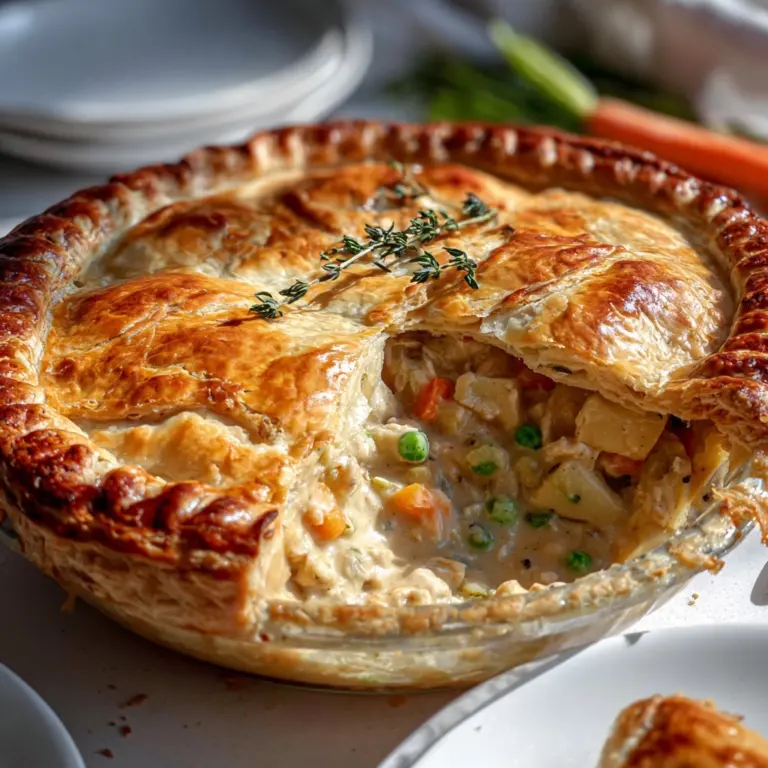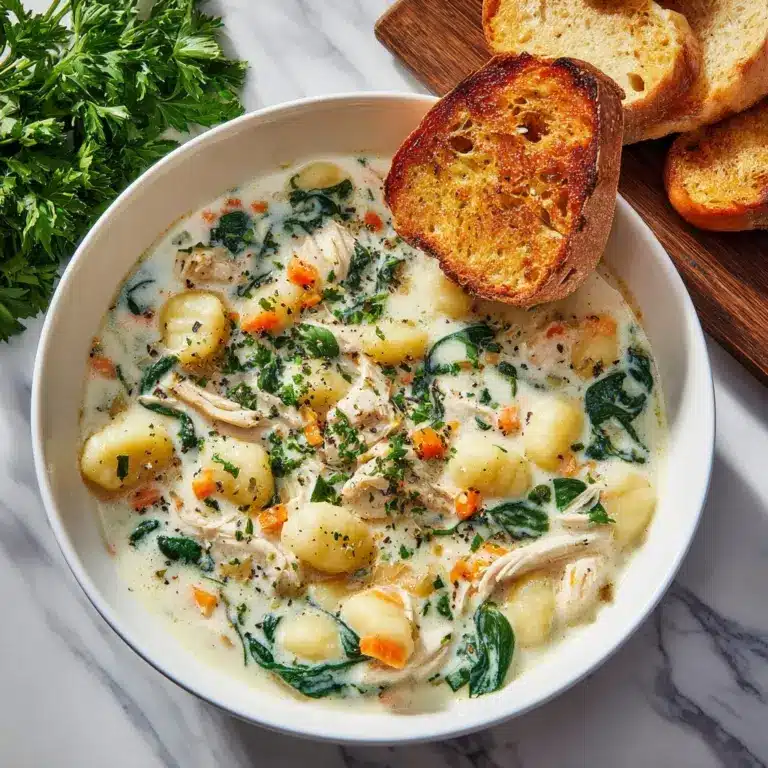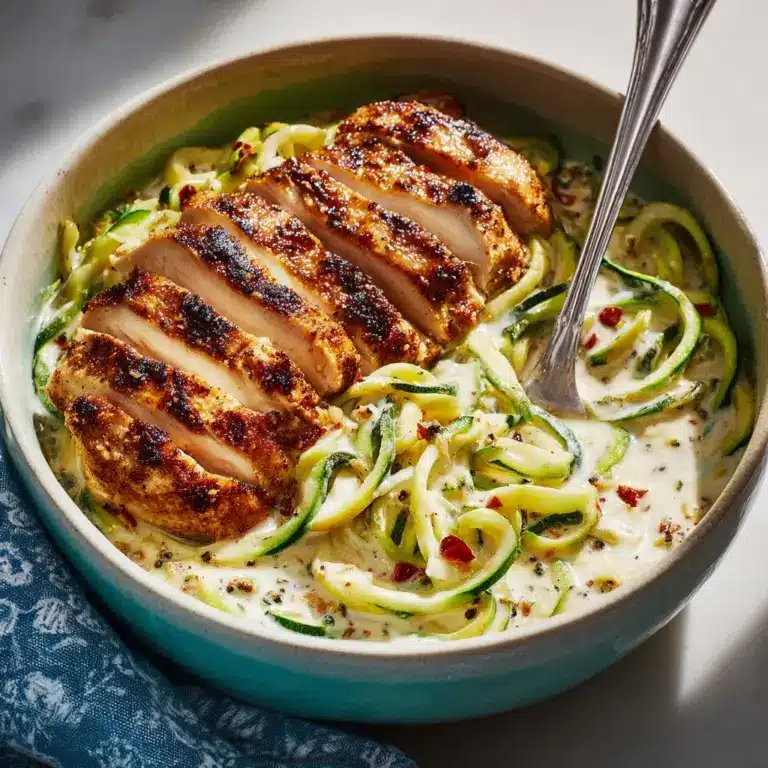Homemade Pasta Alfredo Recipe
Homemade Pasta Alfredo is the ultimate fusion of rustic comfort and elegant dining, blending silky ribbons of fresh pasta with a creamy, deeply flavorful sauce. This dish transforms simple ingredients into a restaurant-worthy meal and is pure magic for pasta lovers. Each component plays a unique role, resulting in a satisfying, warming plate you’ll want to return to again and again.
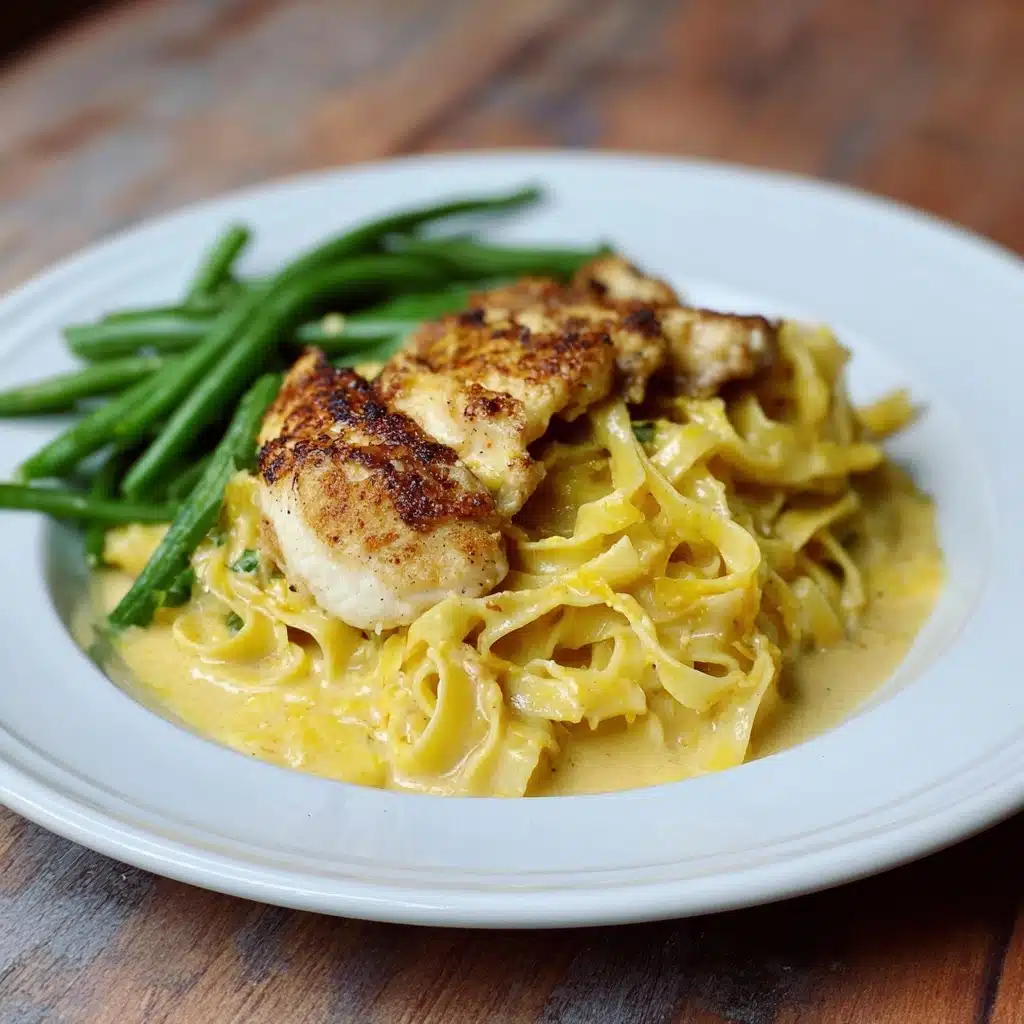
Ingredients You’ll Need
The beauty of Homemade Pasta Alfredo comes from both its simplicity and the high quality of ingredients—all of which build tremendous flavor and luscious texture. Each item here serves its own special purpose, making this dish truly unforgettable.
- All-Purpose Flour: The foundation of your homemade pasta, producing a delicate yet sturdy bite. Dust extra for rolling and shaping!
- Whole Eggs & Egg Yolks: Both provide richness, moisture, and golden color to the dough, ensuring noodles that are tender and flavorful.
- Kosher Salt: Adds depth and elevates flavors in both the pasta dough and boiling water.
- Parmigiano Reggiano Cheese: The star of the sauce, imparting nutty umami and a crave-worthy creamy finish.
- Heavy Cream: Delivers that signature Alfredo silkiness without overpowering the cheese.
- Large Egg: Binds and enriches the sauce so it clings luxuriously to every noodle.
- Cornstarch: Ensures a smooth, glossy sauce by thickening it just enough.
- Olive Oil: Adds depth of flavor and an extra hit of richness to both the pasta and the sauce; drizzle more to finish!
- Salt and Pepper: Season everything to perfection, with black pepper bringing a gentle warmth that cuts through the richness.
- Garlic: Four cloves add subtle, aromatic undertones that balance the creamy, cheesy sauce.
- Unsalted Butter: Rounds out the sauce with decadence and encourages velvety smoothness.
- Fresh Chives or Parsley (optional): Sprinkle on top for a fresh, peppery bite and a burst of color.
How to Make Homemade Pasta Alfredo
Step 1: Create the Pasta Dough
Kick off your Homemade Pasta Alfredo adventure by shaping a mound of flour on a roomy, clean work surface. Make a well in the center, then pour in your eggs, yolks, and a sprinkle of salt. Whisk the eggs gently with a fork, slowly drawing in flour from the edges until a shaggy, sticky dough forms. Don’t worry if it looks messy at first—this is authentic pasta making at its best!
Step 2: Knead and Rest the Dough
Switch to a bench scraper and knead more flour into the dough bit by bit. Fold and turn the dough until it starts feeling firm and less sticky—about 2 to 5 minutes of honest work. Now, invest a few more minutes to knead by hand. You’re aiming for a smooth, elastic ball. Wrap the dough tightly in plastic and let it rest for 30 minutes on your counter. This little pause is the secret to an easy-to-roll, tender pasta.
Step 3: Roll and Cut the Pasta
Dust a baking sheet with flour and line it with parchment to prep a resting spot for your finished noodles. Divide the dough into quarters, and keep the unused pieces wrapped as you work. Flatten one quarter with a rolling pin to about half an inch thick. Using a pasta machine, pass the dough through the widest setting once or twice. Fold the ends into the center and flatten again. Keep rolling the dough through narrower settings, one notch at a time, until you have long, delicate sheets you can almost see through.
Step 4: Shape the Pasta Nests
Lay the silky pasta sheet out on your floured work surface. Fold the dough over itself a few times, dusting between each fold to prevent sticking. Slice with a sharp chef’s knife into your favorite width (fettuccine, tagliatelle, your call!). Gently shake the ribbons loose, then twirl into a tidy nest. Repeat with remaining dough, setting each nest on the prepared baking sheet to prevent sticking.
Step 5: Prepare the Alfredo Sauce
In a big bowl, combine your Parmigiano Reggiano, heavy cream, egg, cornstarch, olive oil, and (if you like) a bit of lemon zest for a pop of brightness. Season lightly with salt and generously with black pepper. Whisk well until creamy and totally smooth. Set this heavenly sauce base aside—you’ll finish it in the pan.
Step 6: Cook the Pasta and Finish the Sauce
Bring a large pot of salted water to a rolling boil. Add your pasta, stirring as it cooks (fresh noodles only need about 45 seconds). Save about two cups of that starchy cooking water—it’s liquid gold for the sauce. In the empty pot, melt butter and gently sizzle your minced garlic until fragrant. In a separate bowl, whisk 1 ½ cups hot pasta water into your cheese mixture, then pour it back into the warm pot. Over medium-high heat, stir continuously as the mixture thickens and transforms into a luscious Alfredo sauce.
Step 7: Toss and Serve
Add your drained, piping-hot pasta to the sauce and toss gently until every ribbon is coated in creamy goodness. If needed, thin the sauce with a splash more pasta water. Serve immediately—Homemade Pasta Alfredo waits for no one! Top with fresh herbs and an extra shower of cheese. Enjoy every irresistible, cheesy bite.
How to Serve Homemade Pasta Alfredo
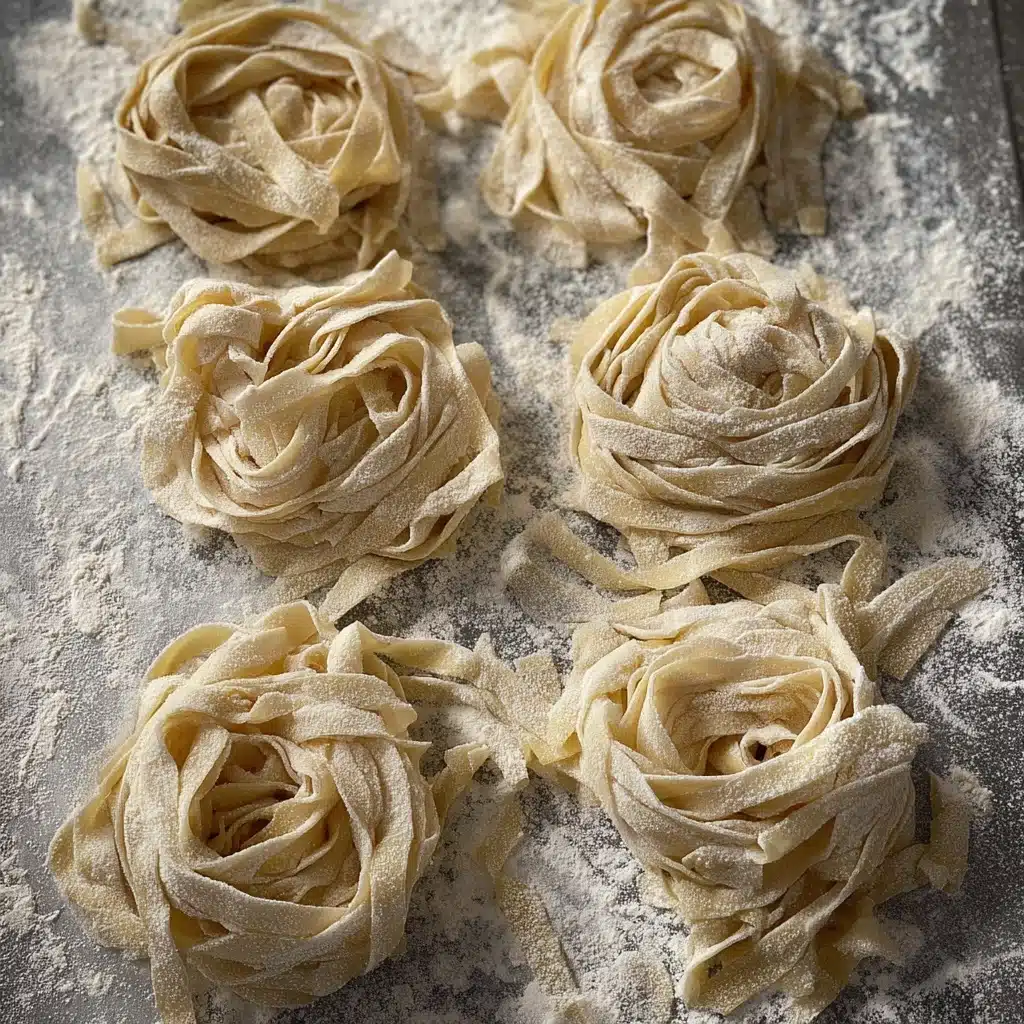
Garnishes
The finishing touches are half the fun. A confetti of chopped chives or parsley brightens the plate and adds a fresh green note. For added drama (and flavor), offer more Parmigiano Reggiano to grate over the top just before serving. If you like a whisper of heat, a grind of black pepper or even some freshly zested lemon gives your Homemade Pasta Alfredo a zippy edge.
Side Dishes
Pair this creamy dish with a crisp green salad tossed in a vinaigrette, or serve roasted broccoli or asparagus on the side—the veggies will balance the rich sauce beautifully. For extra comfort, a warm, crusty baguette is perfect for mopping up any Alfredo left behind. If you’re feeling a bit fancy, a glass of chilled white wine brings the whole meal together.
Creative Ways to Present
Transform Homemade Pasta Alfredo from weekday dinner to dinner-party centerpiece by nestling it into shallow bowls with artful twirls, topped with microgreens or edible flowers. For a rustic family-style meal, pile the noodles high on a big platter and let everyone help themselves. Mini ramekins make an adorable appetizer, or you can even serve in parmesan cheese bowls for a showstopping edible presentation.
Make Ahead and Storage
Storing Leftovers
If you somehow find yourself with leftover Homemade Pasta Alfredo, transfer it to an airtight container as soon as it cools. It keeps beautifully in the fridge for up to three days, and the flavors continue to meld and develop, making leftovers something to genuinely look forward to.
Freezing
While fresh pasta is best enjoyed the day it’s made, you can freeze both the uncooked pasta nests and finished Alfredo sauce separately. Shape and freeze pasta nests on a tray until firm, then stash in zip-top bags for up to two months. Alfredo sauce freezes well too—store it in small portions so you can reheat just what you need.
Reheating
To reheat, add a splash of milk or cream to the sauce and gently warm it on the stovetop over low heat, stirring often to keep things creamy. For best results, avoid the microwave, which can make the sauce separate. Toss the reheated sauce with fresh-cooked or thawed pasta, and your Homemade Pasta Alfredo will be almost as dreamy as when first made.
FAQs
Can I use store-bought pasta for Homemade Pasta Alfredo?
Absolutely! While fresh pasta takes everything up a notch, using high-quality dried fettuccine or tagliatelle is still a delicious and convenient choice. Just cook until barely al dente before tossing with the sauce for a satisfying meal that comes together more quickly.
Why is my Alfredo sauce grainy?
A grainy sauce usually means the cheese didn’t melt smoothly. For best results, use freshly grated Parmigiano Reggiano (pre-grated can contain anti-caking agents) and whisk thoroughly when adding warm pasta water to the cheese mixture. Smoothly melting cheese is the key to that classic Alfredo silkiness.
Can I make Homemade Pasta Alfredo gluten-free?
Yes, you can! Substitute a 1-to-1 gluten-free baking flour for regular flour when making the pasta dough, or use your favorite gluten-free pasta. The sauce itself contains no gluten, so it’s naturally friendly to gluten-free diets.
What proteins go well with Homemade Pasta Alfredo?
Grilled or roasted chicken, shrimp, or even crispy pancetta are all classics with Alfredo. Simply serve alongside or layer on top for an even heartier meal. For vegetarians, roasted mushrooms are a fantastic addition.
How do I keep my pasta from sticking together?
Be sure to dust the sliced noodles with flour as you fold and shape them, and toss them in plenty of boiling salted water during cooking. Once drained, immediately toss the noodles with the sauce—which acts as a delicious barrier—and serve right away.
Final Thoughts
Making Homemade Pasta Alfredo is a beautiful way to bring everyone to the table with smiles and satisfied bellies. This dish is both comforting and a little luxurious, turning classic flavors into something truly memorable. You’ll be amazed by the flawless texture and depth of taste—and even more delighted by the pleasure of sharing it with those you love. Give this Homemade Pasta Alfredo a try soon; it just might become your new favorite kitchen ritual!
Print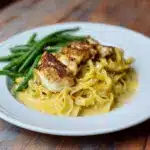
Homemade Pasta Alfredo Recipe
- Total Time: 55 minutes
- Yield: 4 servings 1x
- Diet: Vegetarian
Description
Learn how to make a delicious homemade Pasta Alfredo from scratch. This recipe combines freshly made pasta with a creamy, cheesy Alfredo sauce for a comforting and satisfying meal that will impress your family and friends.
Ingredients
For the pasta:
- 2 cups all-purpose flour, plus more for dusting
- 2 large whole eggs
- 4 large egg yolks
- 1 tsp kosher salt, plus more for salting the water
For the sauce:
- 5 oz grated Parmigiano Reggiano cheese
- 2 tbsp heavy cream
- 1 large egg
- 1 tsp cornstarch
- 2 tbsp olive oil, plus more for serving
- Salt and pepper to taste
- 4 garlic cloves, minced
- 2 tbsp unsalted butter
- Fresh chives or parsley, optional, for serving
Instructions
- To make the pasta: On a large, clean work surface, pour flour in a mound. Make a well in the center. Pour whole eggs, egg yolks, and salt into well and, using a fork, beat thoroughly. When combined, gradually incorporate flour into the eggs until a wet, sticky dough has formed.
- Using a bench scraper, scrape excess dough from fork and fingers. Begin to fold additional flour into the dough with the bench knife, turning the dough roughly 45 degrees each time, until dough feels firm and dry, and can form a ball, 2 to 5 minutes.
- Knead the ball until dough develops a smooth, elastic texture, adjusting the liquid if needed. Wrap ball of dough tightly in plastic wrap and rest on countertop for 30 minutes.
- Meanwhile, place a sheet of parchment on a baking sheet and dust lightly with flour. Unwrap rested dough and cut into quarters. Set one quarter on work surface and re-wrap remaining dough. With a rolling pin, flatten the quarter of dough into an oblong shape about 1/2 inch thick.
- Set pasta maker to widest setting and pass dough once or twice. Place dough on a lightly floured work surface. Fold both ends in so that they meet at the center of the dough, and then fold the dough in half where the end points meet, trying not to incorporate too much air into the folds. Using rolling pin, flatten dough to 1/2-inch thick. Pass through the roller another couple of times.
- Narrow the setting by 1 notch and repeat the last step. Continue passing the dough through the rollers, reducing the thickness by 1 setting each time until it reaches the desired thickness. It should now be very delicate and almost see through.
- Place rolled dough onto a work surface lightly dusted with flour, folding the dough over. Sprinkle with flour between folds to prevent sticking. Fold a few times, then use a chef’s knife to slice into your desired thickness. Shake the pasta ribbons loose and toss with flour. Shape into a nest and place on flour-lined baking sheet, then continue with the rest of the dough.
- For the sauce: Combine cheese, heavy cream, egg, cornstarch, olive oil, and lemon zest (if using) in a large bowl. Season lightly with salt and heavily with black pepper and whisk to combine. Set aside.
- Bring a large pot of salted water to a boil over high heat. Add pasta and cook, stirring frequently to prevent sticking, until cooked but still very firm (not quite al dente), about 45 seconds for fresh pasta or 1-2 minutes less than package directions indicate for dried pasta. Drain pasta into a colander set over a large bowl. Transfer 2 cups of cooking water to a liquid measuring cup and discard the rest. Transfer pasta to the now-empty bowl. Add garlic and butter and toss to coat.
- Whisking constantly, slowly add 1 1/2 cups of pasta cooking water to bowl with cheese mixture. Transfer cheese mixture to the now-empty pasta cooking pot, scraping the bottom to make sure you get everything. Cook over medium-high heat, stirring constantly with a rubber spatula, until mixture comes to a boil and thickens. Season sauce to taste with more salt and pepper as desired. Transfer pasta to sauce mixture and turn to coat. Just before serving, stir in more pasta water to thin sauce out as necessary. Serve immediately or it will stick together. Top with herbs if using and more cheese.
Notes
- You can customize this recipe by adding cooked chicken, shrimp, or vegetables to the Alfredo sauce.
- For a lighter version, you can use half-and-half instead of heavy cream.
- Make sure to season the pasta water well with salt to enhance the flavor of the noodles.
- Prep Time: 45 minutes
- Cook Time: 10 minutes
- Category: Main Dish
- Method: Cooking, Mixing
- Cuisine: Italian
Nutrition
- Serving Size: 1 serving
- Calories: 620
- Sugar: 2g
- Sodium: 550mg
- Fat: 27g
- Saturated Fat: 13g
- Unsaturated Fat: 10g
- Trans Fat: 0g
- Carbohydrates: 68g
- Fiber: 3g
- Protein: 23g
- Cholesterol: 190mg
Keywords: Pasta Alfredo, Homemade Pasta, Alfredo Sauce, Italian Recipe, Pasta Recipe


